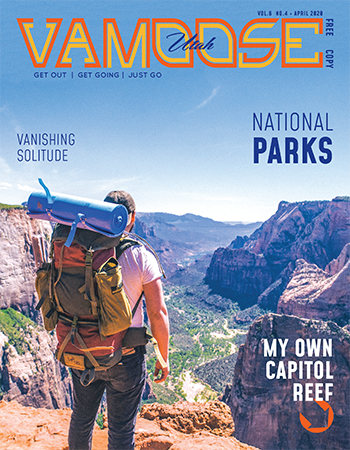Imagine Edward Abbey’s response to today’s congested national parks
By John Rasmuson
Edward Abbey was hired as a seasonal park ranger at Arches National Monument in 1956. He was 29. Part of his job was to man the entry station. It stood alongside a dirt road 20 miles north of Moab, which was “the uranium capital of the world” at the time. On most days, no visitors showed up. By the end of the year, just 28,500 people had navigated rough roads for a look at some of the 2,000 redrock arches they had heard about.

“Motorized tourists stay away by the millions,” Abbey wrote in Desert Solitaire, his classic memoir of the two summers he worked at Arches. “They stay away because of the unpaved entry road, the unflushable toilets in the three campgrounds and the fact that most of them have never even heard of Arches National Monument.”
But as every sandstone arch attests, change is as inevitable as it is consequential: Pave a road and they will come. The first nine miles of asphalt were laid at Arches in 1957. A visitor center with running water opened in 1969, a year after the publication of Desert Solitaire. By the time Arches became a national park in 1971, more than 200,000 people a year were making the long drive to check it out. The park’s 18-mile loop road was resurfaced in 2017, a boon to the motorized tourists who preferred to see the park’s treasures through the windshield.
Visitors to the park reached the 1 million mark in 2010. Nine years later, boosted by the Utah Office of Tourism’s Mighty 5 advertising campaign, more than 1.5 million people now visit annually. Some weekends, a line of idling cars back up on U.S. 191 as hundreds of tourists queue at the entrance. On Oct. 18, 2019, at 1 p.m., the National Park Service (NPS) had to close the door. “Arches National Park is currently full,” it tweeted.
Abbey, who died in 1989, would have recoiled at motorized tourists gathering like barbarians at the gate. He would have fumed. Then despaired. Then cussed. “Goddamned industrial tourism!” he would have ranted. In his mind, a cabal of car makers, road builders, developers, restaurateurs, hoteliers and gasoline retailers posed an existential threat to the national parks. The car-bound tourists he objectified were at once “the consumers, the raw material and the victims of industrial tourism.”
Abbey would have also disparaged Utah’s tourism office as being a running dog of the soulless industrialists. Its $3 million promotion in 2013—featuring curated images of Arches, Zion, Capitol Reef, Bryce and Canyonlands—included TV commercials in Los Angeles, Denver, Phoenix, Portland, San Francisco and Seattle. Within five years, the number of visitors increased by 68%.

Bryce Canyon National Park
To protect Arches’ fragile landscape from the onslaught, Abbey advocated a ban on cars and a repurposed NPS to deliver the backpacks of walkers and cyclists to campgrounds. The radical plan won’t be adopted anytime soon, but the need to manage the growing, peak-season crowds is urgent. The NPS at Arches borrowed on the experience at Maine’s Acadia National Park to propose a reservation system and 2,000-cars-a-day limit between March and October. The proposal was met with brickbats. Should vehicle-entry reservations be required, critics said, the annual cost in lost tourist dollars would exceed $20 million. The NPS quickly withdrew the proposal and took up a study of mandatory shuttles and a second entrance to the park.
At the launch of the Mighty 5 campaign, Utah Gov. Gary Herbert said, “Utah’s five stunning national parks contribute to Utah’s economy in a meaningful way by creating much-needed jobs and impacting local economies in gateway communities and surrounding areas.”
Herbert, whose lack of support of Bears Ears and Grand Staircase-Escalante national monuments caused the Outdoor Retail Association to take its business to Denver, made no mention of Abbey’s assertion that “wilderness is not a luxury but a necessity of the human spirit and as vital to our lives as water.” Neither did it come up in a recent letter to the secretary of the interior from the Utah congressional delegation about crowd management at Zion National Park. With its 4-million-plus visitors a year, Zion is one of the busiest parks in the country and “a pillar of the local tourism economy, helping support jobs and generate revenue.” The letter, signed by Utah senators Lee and Romney and four congressmen, expressed “strong opposition to any reservation system” because it would “likely result in reduced visitation and negative economic impact,” they wrote. “We strongly urge the department to find solutions that will preserve access to Zion National Park while enhancing the visitor experience.”
Abbey would have scoffed at the mere mention of unrestricted crowds enhancing a wilderness experience. Where is the point of diminishing returns? he would ask. Five million visitors annually at Zion? Three thousand cars a day at Arches? At what point do parking hassles, toilet lines and congested trails dominate the memory of a sunset hike to Delicate Arch? How crowded does it have to get before visitors simply go elsewhere?
Motorists no longer stay away by the millions as they did in Abbey’s day. The Mighty 5 promotion has been mighty successful, no question about it; and no question that politicians side with the moneyed interests of industrial tourism.
The nascent interest in building a second entry to Arches found a voice in the 2020 legislative session. Proposed by Rep. Steve Eliason, R-Sandy, a new state park, named for the Utahraptor dinosaur, is configured such that access to Arches is possible. An investment of $10 million would fund roads, parking lots and restrooms on a 6,500-acre site straddling U.S. 191, Eliason said at a press conference with a smiling Moab mayor. Besides the Dalton Wells Quarry, the source of the first fossilized bones of a Utahraptor, the terrain is crisscrossed with ATV and mountain bike trails, Eliason said. Were Abbey alive, he’d be thinking about monkey-wrenching a project that would bring more vehicles into Arches.
In his famous 1975 novel, Abbey made a verb of a plumber’s tool, the monkey wrench. In writing, he tapped the lexicon of lawyers to describe himself as Arches’ “usufructuary.” The word refers to the long-term use of someone else’s property with the proviso it remain intact and undamaged. Thus, the usufruct of another’s orchard requires care of the trees and replacement of any that die.
Hints of usufruct can be found in the Office of Tourism’s latest strategic plan. In privileging “the quality of visits rather than the quantity of visitors,” the nine-page plan promotes “responsible visitation” even in its avowal to leverage “the equity of the Mighty 5 brand” for statewide economic growth. From the tourist office point of view, overcrowded national parks pose “a significant risk to the future of Utah’s tourism industry.”
For Abbey, the crowds at Arches are symptomatic of industrial tourism run amok. He would despair that “wilderness” was missing from the pages of Utah’s strategic tourism plan just as it is missing more and more from Utah’s redrock landscape.
Abbey wrote Desert Solitaire as an elegy for wilderness lost, but the book is also intended as an enjoinder to us—usufructuaries all—to steward what wilderness remains for the benefit of those who follow.




